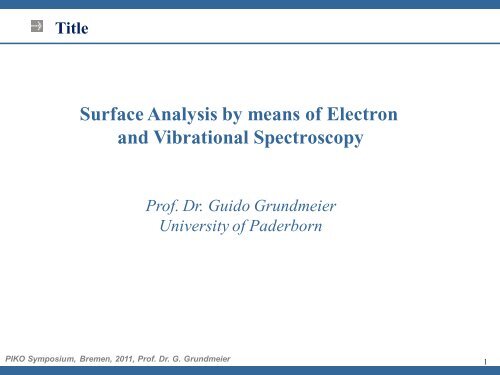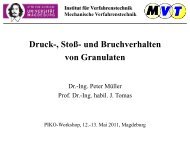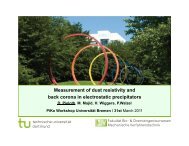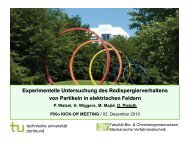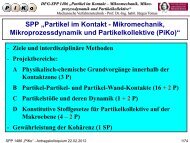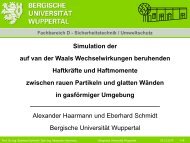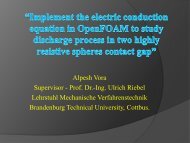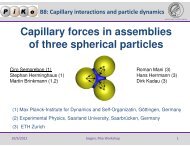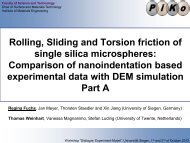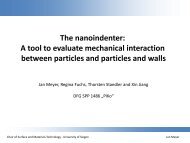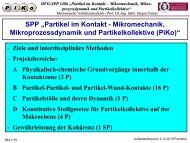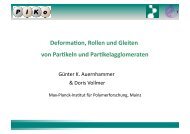Guido Grundmeier
Guido Grundmeier
Guido Grundmeier
You also want an ePaper? Increase the reach of your titles
YUMPU automatically turns print PDFs into web optimized ePapers that Google loves.
Title<br />
Surface Analysis by means of Electron<br />
and Vibrational Spectroscopy<br />
Prof. Dr. <strong>Guido</strong> <strong>Grundmeier</strong><br />
University of Paderborn<br />
PIKO Symposium, Bremen, 2011, Prof. Dr. G. <strong>Grundmeier</strong><br />
1
Contents<br />
• Electron Spectroscopy of Surfaces<br />
• Theory<br />
• Applications<br />
• Optical Spectroscopy<br />
• FT-IR spectroscopy - Theory<br />
• Applications<br />
PIKO Symposium, Bremen, 2011, Prof. Dr. G. <strong>Grundmeier</strong><br />
2
Electron Beam - Sample Interaction<br />
5-50 nm<br />
X-ray<br />
Fluorescence<br />
Continuum X-rays<br />
(Bremsstrahlung – “breaking radiation”)<br />
PIKO Symposium, Bremen, 2011, Prof. Dr. G. <strong>Grundmeier</strong><br />
3
Energy distrib. of backscattered/emitted electrons<br />
Regions of interest:<br />
I. Elastically scattered primary electrons (structure, vibrational information)<br />
II. Electronic excitations (phonon and plasmon losses)<br />
III. Auger electrons (inelastic background)<br />
IV. Secondary electrons (“True” emission electrons)<br />
e - e -<br />
G.A. Somorjai, “Introduction to Surface Chemistry and Catalysis” (Wiley, New York, 1994), p.384<br />
PIKO Symposium, Bremen, 2011, Prof. Dr. G. <strong>Grundmeier</strong><br />
4
Mean free path of electrons in solid matter<br />
(1 ML ~ 2.5 Å)<br />
UPS<br />
XPS and AES<br />
Mean free path of electrons in the order of 1 nm surface sensitivity<br />
The surface sensitivity depends on the probability of the electron to reach<br />
the surface without a loss of energy (e.g. inelastic collisions). The<br />
penetration depth of the excited particles/radiation can be orders of<br />
magnitude higher!<br />
G.A. Somorjai, “Introduction to Surface Chemistry and Catalysis” (Wiley, New York, 1994), p.383<br />
PIKO Symposium, Bremen, 2011, Prof. Dr. G. <strong>Grundmeier</strong><br />
5
Photoelectron emission by means of X-rays<br />
Electron or X-ray<br />
photon<br />
Auger Electron<br />
Spectroscopy<br />
AES<br />
X-ray Photoelectron<br />
Spectroscopy<br />
XPS<br />
X-ray photon<br />
Ultraviolet Photoelectron<br />
Spectroscopy<br />
UPS<br />
UV photon<br />
E vac<br />
E vac<br />
V<br />
E L2,3<br />
2p 1/2 , 2p 3/2<br />
E L1<br />
E K<br />
2s 1/2<br />
1s 1/2<br />
E kin = E K -E L1 -E L23 -<br />
E kin = h -E K -<br />
E kin = h -E V -<br />
PIKO Symposium, Bremen, 2011, Prof. Dr. G. <strong>Grundmeier</strong><br />
6
Photoelectron spectroscopy<br />
Principles:<br />
• Ejection of electrons from atoms, molecules, amorphous or crystalline solids<br />
following a bombardment by monochromatic photons (compare: photoelectric effect)<br />
• Photoelectrons are emitted above a treshold frequency of the incoming photons<br />
h<br />
I<br />
1<br />
2<br />
2<br />
m e<br />
v<br />
For XPS/<br />
M h<br />
UPS:<br />
M<br />
e<br />
PIKO Symposium, Bremen, 2011, Prof. Dr. G. <strong>Grundmeier</strong><br />
7
Photoelectron emission by means of X-rays<br />
E kin<br />
0<br />
Now excitation with X-rays: h >><br />
Determination of core levels<br />
Reflect inner electronic structure<br />
Energy balance:<br />
h<br />
E vac = 0<br />
E F<br />
VB<br />
E B<br />
h<br />
h<br />
core level<br />
core level<br />
h<br />
I<br />
DOS<br />
E B<br />
E kinetic = h – E binding (solid)<br />
Since each element has unique set of core levels<br />
E kin can be used to fingerprint element<br />
Regarding the photoemission process:<br />
• Needed: monochromatic (X-ray) incident beam<br />
• Absorption very fast: t ~ 10 -16 s<br />
• No photoemission for hν <<br />
• No photoemission from levels with E B + > hν<br />
• E kin of photoelectron increases as E B decreases<br />
PIKO Symposium, Bremen, 2011, Prof. Dr. G. <strong>Grundmeier</strong><br />
8
Typical XP Spectrum<br />
PIKO Symposium, Bremen, 2011, Prof. Dr. G. <strong>Grundmeier</strong><br />
9
Binding Energy of Electrons<br />
Calculation of Binding Energies of Electrons:<br />
Determination of the binding energy (BE):<br />
KE = h – BE ↔ BE = h – KE<br />
The Binding Energy of electrons is normally is referred to the Fermi Level. (BE = E BF ).<br />
Attention: For the measurement, the work function of the spectrometer is relevant!<br />
Calibration via a reference of known binding energy!<br />
Usually the negative value of the BE is used leading to positive values in the spectra.<br />
Contributions to the binding energy:<br />
1.<br />
2.<br />
Atomic base-contribution : E 0 bind<br />
Chemical shift: E chem<br />
3. Relaxation term: E relax<br />
BE = E 0 bind + E chem + E relax<br />
PIKO Symposium, Bremen, 2011, Prof. Dr. G. <strong>Grundmeier</strong><br />
10
Primary PE structure: Contrib. of the atomic species<br />
Contribution of the atomic species E 0 bind:<br />
The binding energy represents strength of the electromagnetic interaction between the<br />
electron (n,l,m,s) and the charge of the nucleus<br />
• In gases: BE ≡ Ionization potential (n, l, m, s)<br />
• BE follows energy of levels: BE(1s) > BE(2s) > BE(2p) > BE(3s) …<br />
• BE of a selected orbital increases with Z: BE(Na 1s) < BE(Mg 1s) < BE(Al 1s)…<br />
• BE of a selected orbital is not affected by isotope effects: BE(7Li 1s) = BE(6Li 1s)<br />
PIKO Symposium, Bremen, 2011, Prof. Dr. G. <strong>Grundmeier</strong><br />
11
PE structure: Peak labeling<br />
Cu 2p 3/2<br />
Spin-orbit coupling: |j| = l + s<br />
Total angular momentum quantum number j<br />
Azimuthal quantum number l<br />
Principal quantum number n<br />
Chemical symbol<br />
E<br />
M<br />
L<br />
3<br />
2<br />
d (l=2)<br />
p (l=1)<br />
s (l=0)<br />
p (l=1)<br />
s (l=0)<br />
5/2<br />
3/2<br />
3/2<br />
1/2<br />
1/2<br />
3/2<br />
1/2<br />
1/2<br />
3d 5/2<br />
3d 3/2<br />
3p 3/2<br />
3p 1/2<br />
3s<br />
2p 3/2<br />
2p 1/2<br />
2s<br />
Binding Energy / eV<br />
K<br />
1<br />
s (l=0)<br />
1/2<br />
1s<br />
n l |j| BE / eV<br />
PIKO Symposium, Bremen, 2011, Prof. Dr. G. <strong>Grundmeier</strong><br />
12
PE structure: Binding energy of core electrons<br />
PIKO Symposium, Bremen, 2011, Prof. Dr. G. <strong>Grundmeier</strong><br />
13
Primary PE structure: Chemical shifts<br />
The chemical shift E chem :<br />
The energy of the core shell electron level is<br />
influenced by the atom´s electron density of the<br />
outer shells.<br />
Shielding of the core shell electrons!<br />
Influenced by the electro-negativity of the next<br />
neighbor atoms!<br />
The BE depends on the chemical state<br />
Chemical shift as a fingerprint<br />
Electron density of H 2 O<br />
(Calculated with density functional<br />
DFT)<br />
PIKO Symposium, Bremen, 2011, Prof. Dr. G. <strong>Grundmeier</strong><br />
14
Primary PE structure: Chemical shifts<br />
A simplified explanation:<br />
Remove a d shell electron, e.g. by bonding to oxygen<br />
Levels shift down (higher BE) simply by<br />
electrostatic reasons<br />
Core level chemical shifts:<br />
• related to the overall charge on the atom<br />
reduced charge increased B.E.<br />
• number of substituents<br />
• electronegativity of the substituent<br />
• formal oxidation state<br />
Chemical Shift is important for identifying:<br />
• functional groups<br />
• chemical environments<br />
• oxidation states<br />
M M +<br />
PIKO Symposium, Bremen, 2011, Prof. Dr. G. <strong>Grundmeier</strong><br />
15
Calculated BE / eV<br />
PE structure: Chemical shift as a fingerprint<br />
EffectivePauling's charge :<br />
q<br />
p,A<br />
AB<br />
i<br />
q<br />
e<br />
Ionicity:<br />
B<br />
i<br />
AB<br />
1 exp 0.25<br />
i<br />
EN<br />
A<br />
EN<br />
B<br />
i<br />
2<br />
Experimental BE / eV<br />
J.H. Scofield, J. Elect. Spec. 8 (1976) 129.<br />
PIKO Symposium, Bremen, 2011, Prof. Dr. G. <strong>Grundmeier</strong><br />
16
Classical example: Chemical shifts for the C1s peak<br />
Ethylene-trifluoroacetate:<br />
C 2 H 5 -O-CO-CF 3<br />
All four carbon atoms have a different<br />
neighboring atoms species that have different<br />
electro-negativities.<br />
All four carbon atoms have a different<br />
chemical environment.<br />
XPS spectrum shows 4 C1s peaks with<br />
three different chemical shifts.<br />
PIKO Symposium, Bremen, 2011, Prof. Dr. G. <strong>Grundmeier</strong><br />
17
Examples of XP-spectra<br />
Oxide covered Si:<br />
Si2p<br />
After removal<br />
of background<br />
and Si2p 1/2<br />
N-containing adsorbates on Si:<br />
N1s<br />
PIKO Symposium, Bremen, 2011, Prof. Dr. G. <strong>Grundmeier</strong><br />
18
XPS investigations on TiO 2 powder samples<br />
• chemical composition of particles?<br />
• oxidation state of Ti?<br />
• immobilization of nanoparticles (d = 110 nm) on an Indium foil<br />
detector<br />
X-ray source<br />
analyzer<br />
monochromator<br />
TiO 2 particles<br />
Indium foil<br />
In<br />
PIKO Symposium, Bremen, 2011, Prof. Dr. G. <strong>Grundmeier</strong><br />
19
Ti LMM<br />
Ti LMM1<br />
XPS investigations on TiO 2 powder samples<br />
• survey spectrum: XPS- and Auger-Peaks<br />
Ti3s Ti3p<br />
O KLL<br />
Ti2s<br />
O1s<br />
Ti2p<br />
C1s<br />
O2s<br />
PIKO Symposium, Bremen, 2011, Prof. Dr. G. <strong>Grundmeier</strong><br />
20
CPS<br />
CPS<br />
CPS<br />
XPS investigations on TiO 2 powder samples<br />
‣ quantification of sample composition via detail spectra<br />
60<br />
50<br />
40<br />
30<br />
20<br />
10<br />
x 10 2<br />
Ti2p<br />
peak area of 1:2<br />
is fixed by spinorbit<br />
coupling!<br />
Ti2p1/2<br />
Ti2p3/2<br />
17.9 at%<br />
80<br />
70<br />
60<br />
50<br />
40<br />
30<br />
20<br />
x 10 2<br />
O1s<br />
OH<br />
13.3 at% 37.6 at%<br />
O<br />
12<br />
10<br />
8<br />
6<br />
4<br />
2<br />
x 10 2<br />
C1s<br />
1.1 at%<br />
C-O<br />
C-C<br />
30,1 at%<br />
468 464 460 456 452<br />
Binding Energy (eV)<br />
Binding Energy (eV)<br />
534 531 528 525<br />
Binding Energy (eV)<br />
Binding Energy (eV)<br />
291 288 285 282<br />
Binding Energy (eV)<br />
Binding Energy (eV)<br />
‣ oxidation state of Ti is Ti 4+ as followed by the Ti2p doublet<br />
‣ significant amount of carbon: residues of particle synthesis and/or contaminations<br />
‣ oxides and hydroxides, in total excess in oxygen compared to the 1:2 stochiometry of TiO 2<br />
‣ no information about TiO 2 modification (Anatase vs. Rutile vs. amorphous) in XPS<br />
PIKO Symposium, Bremen, 2011, Prof. Dr. G. <strong>Grundmeier</strong><br />
21
Chemical shifts of Ti compounds<br />
5<br />
Ti 2p 3/2<br />
4<br />
TiO 2<br />
Ti valency<br />
3<br />
2<br />
10<br />
8<br />
Ti2p exp.<br />
Ti2p3 458.8 eV<br />
Ti 2<br />
O 3<br />
TiO<br />
6<br />
1<br />
CPS / 10 3<br />
4<br />
22.0 %<br />
2<br />
0<br />
0<br />
470 465 460 455<br />
Binding energy / eV<br />
44.8 %<br />
Ti (metallic)<br />
460<br />
458<br />
456<br />
454<br />
Binding Energy / eV<br />
PIKO Symposium, Bremen, 2011, Prof. Dr. G. <strong>Grundmeier</strong><br />
22
Secondary Structure: Surface charging<br />
Surface charging:<br />
‣ Electrical insulators cannot dissipate charge generated by<br />
the photoemission process!<br />
‣ Surface picks up excess positive charge!<br />
All peaks shift to higher binding energies<br />
‣ Especially: Organic compounds, oxides and ceramics<br />
‣ Uncritical: Metals, semiconductors, very thin films<br />
‣ Can be reduced by exposing the surface to a neutralizing<br />
flux of low energy electrons: “flood gun” or “neutralizer”<br />
‣ But the charge can be overcompensated by the neutralizer!<br />
‣ Good reference peak important!<br />
Often used C1s: C-C 284.5 eV<br />
- - - -<br />
-<br />
PIKO Symposium, Bremen, 2011, Prof. Dr. G. <strong>Grundmeier</strong><br />
Insulating<br />
sample<br />
Insulating<br />
sample<br />
23
Quantitative analysis: Photoelectron intensity<br />
I<br />
A<br />
A<br />
h<br />
D E<br />
KIN<br />
L<br />
A<br />
T<br />
E<br />
KIN<br />
N<br />
A<br />
M<br />
cos(<br />
)<br />
I S ( ) L<br />
A<br />
A<br />
A<br />
T<br />
E<br />
KIN<br />
N<br />
A<br />
z<br />
∞<br />
hν<br />
γ<br />
δ<br />
I A – Photoelectrons current from A-Element<br />
A – Element in Matrix M<br />
L A (γ) – Angular asymmetry of the intensity<br />
of the intensity of the photoemission from each atom<br />
T(xyγΦE A ) – analyzer transmission<br />
N A – atom density of the A atoms at (xyz)<br />
x<br />
θ<br />
Φ<br />
ē<br />
(hν) – cross-section for emission of a<br />
photoelectron from the relvant inner shell<br />
per atom of A by photon of enrergy hν<br />
z<br />
y<br />
S A ( ) – Sensitivity factor for element A<br />
– Take-off angle of photo electrons<br />
PIKO Symposium, Bremen, 2011, Prof. Dr. G. <strong>Grundmeier</strong><br />
24
Quantification: sensitivity factors<br />
Quantification:<br />
If is difficult to apply calculated cross sections directly to the measured data sets<br />
(e.g. other instrumental data sets need to be included, as well as loss processes lowering the<br />
intensity at the peak position)<br />
‣ Most analyses use empirical calibration factors<br />
(called atomic sensitivity factors) derived from<br />
standards:<br />
I measured = S A x N a<br />
‣ Note: Sensitivity for each element in a<br />
complex mixture can vary!<br />
‣ A typical accuracy of less that 15% can be reached<br />
by using sensitivity factors!<br />
PIKO Symposium, Bremen, 2011, Prof. Dr. G. <strong>Grundmeier</strong><br />
25
Quantification: Background subtraction<br />
How to determine I measured ?<br />
• Remember: “Stepped” structure of the<br />
background signal<br />
step background<br />
• Suitable background determination needed:<br />
Shirley background usually used!<br />
By using a suitable background:<br />
linear background<br />
• Accuracy better than 15 % using ASF's<br />
• Use of standards measured on same<br />
instrument or full expression above<br />
accuracy better than 5 %<br />
Shirley background<br />
• In both cases, reproducibility (precision)<br />
better than 2 %<br />
PIKO Symposium, Bremen, 2011, Prof. Dr. G. <strong>Grundmeier</strong><br />
[D.A. Shirley, Phys. Rev. B5, 4709, 1972]<br />
26
Ti LMM1<br />
Ti LMM<br />
O KLL<br />
Ti2s<br />
Quantification example: TiO 2 on top of stainless steel<br />
0.4<br />
0.2<br />
CPS / 10 5<br />
O1s<br />
Ti2p<br />
C1s<br />
O2s Ti3p Ti3s<br />
Atomic %<br />
Ti2p3 22.9<br />
O1s 50.8<br />
C1s 26.3<br />
c(<br />
at%)<br />
N<br />
1<br />
Area<br />
ASF<br />
Area<br />
ASF<br />
1<br />
Sample<br />
1<br />
Sample<br />
X<br />
Sample<br />
X<br />
Sample<br />
Peak ASF<br />
Ti2p3 1.385<br />
O1s 0.733<br />
C1s 0.314<br />
0.0<br />
1200<br />
1000<br />
800 600 400<br />
Binding energy / eV<br />
200<br />
0<br />
TiO 2 film covers the whole surface<br />
Ti oxidation state: Ti 4+<br />
Ti:O ratio ≈ 1:2<br />
sputtered TiO 2 film<br />
stainless steel<br />
23 nm<br />
PIKO Symposium, Bremen, 2011, Prof. Dr. G. <strong>Grundmeier</strong><br />
27
Mean free path / Å<br />
Quantification: Information depth<br />
‣ The Intensity of the photoelectrons is attenuated by the strong electron-electron interaction<br />
Universal mean free path curve!<br />
High surface sensitivity<br />
‣ The attenuation follows an exponential decay (Lambert-Beer):<br />
‣ The Intensity of the emitted PE can be calculated by integration:<br />
I<br />
x<br />
I ~ exp<br />
I<br />
b<br />
0<br />
x a<br />
exp<br />
x<br />
dx<br />
SiO 2<br />
-<br />
-<br />
suboxide<br />
Si-substrate<br />
-<br />
PIKO Symposium, Bremen, 2011, Prof. Dr. G. <strong>Grundmeier</strong><br />
28
Information depth: Native oxide on top Si<br />
Si2p<br />
Si-substrate<br />
-<br />
native oxide<br />
Si-substrate<br />
-<br />
2-3 nm<br />
native oxide<br />
Si2s<br />
native oxide<br />
Si-substrate<br />
PIKO Symposium, Bremen, 2011, Prof. Dr. G. <strong>Grundmeier</strong><br />
29
Angle resolved XPS: AR-XPS<br />
Detector<br />
Detector<br />
Detector<br />
-<br />
-<br />
-<br />
10 nm<br />
= 90°<br />
sampling depth: 10 nm<br />
= 35°<br />
sampling depth: 5.7 nm<br />
= 10°<br />
sampling depth: 1.7 nm<br />
I<br />
exp<br />
d<br />
sin<br />
d<br />
ln(I)<br />
sin<br />
3<br />
sin<br />
PIKO Symposium, Bremen, 2011, Prof. Dr. G. <strong>Grundmeier</strong><br />
30
Contents<br />
• Electron Spectroscopy of Surfaces<br />
• Theory<br />
• Applications<br />
• Optical Spectroscopy<br />
• FT-IR spectroscopy - Theory<br />
• Applications<br />
PIKO Symposium, Bremen, 2011, Prof. Dr. G. <strong>Grundmeier</strong><br />
31
Optical spectroscopy - Introduction<br />
Diffraction:<br />
Environment<br />
Layer<br />
External reflection:<br />
Material has to reflect<br />
the corresponding<br />
radiation<br />
Material<br />
Internal reflection:<br />
Material needs to be transparent in the<br />
corresponding wavelength region<br />
Information (can be gained most often in-situ):<br />
Layer thickness, optical constants, chemical composition, diffusion constants,<br />
reaction kinetics, orientation, adsorption, corrosion, …<br />
PIKO Symposium, Bremen, 2011, Prof. Dr. G. <strong>Grundmeier</strong><br />
32
Beer–Lambert–Bouguer law<br />
Assumptions:<br />
• Light has to be monochromatic and parallel<br />
• Molecules have to be molecularly dispersed<br />
• There is no diffraction or reflection<br />
dI x<br />
dx<br />
I<br />
x<br />
;<br />
I<br />
x<br />
I<br />
0<br />
e<br />
x<br />
Beer:<br />
dI is proportional to the concentration c!<br />
dI<br />
I x I0<br />
e<br />
c I<br />
dx<br />
c x<br />
I 0<br />
I<br />
molar absorptivity of the absorbing species<br />
Path length x<br />
PIKO Symposium, Bremen, 2011, Prof. Dr. G. <strong>Grundmeier</strong><br />
33
IR Fundamentals<br />
Section of the electromagnetic spectrum: 12500 – 10 cm -1 (0.8 – 1000 m)<br />
~<br />
in<br />
cm<br />
1<br />
Transmittance, T:<br />
Ratio of radiant power transmitted by the sample (I) to the radiant power<br />
incident on the sample (I 0 ).<br />
1<br />
in<br />
Absorbance, A:<br />
Logarithm to the base 10 of the reciprocal of the transmittance (T)<br />
m<br />
10<br />
4<br />
A<br />
log<br />
1<br />
T<br />
lg T<br />
lg<br />
10 I 0<br />
Measurement:<br />
1. Measure Reference Single Beam Spectrum (I 0 )<br />
2. Measure Sample Single Beam Spectrum (I)<br />
3. Divide I/I 0<br />
I<br />
PIKO Symposium, Bremen, 2011, Prof. Dr. G. <strong>Grundmeier</strong><br />
34
A Simple Spectrometer Layout<br />
Fourier Transform IR-Spectrometers: All frequencies are examined simultaneously<br />
Source: http://mmrc.caltech.edu/FTIR/FTIRintro.pdf<br />
PIKO Symposium, Bremen, 2011, Prof. Dr. G. <strong>Grundmeier</strong><br />
35
BRUKER Vertex 70<br />
PIKO Symposium, Bremen, 2011, Prof. Dr. G. <strong>Grundmeier</strong><br />
36
Attenuated Total Reflection (ATR) Spectroscopy<br />
D<br />
d p<br />
n 2 < n 1<br />
n 1<br />
ZnSe(n=2.4) or Ge (n=4.00)<br />
• The electric field of a wave reflected from an interface probes slightly beyond the<br />
interface.<br />
• This penetrating wave is called an evanescent wave.<br />
• It sends energy back and forth across the interface so that absorptions on one side<br />
are transmitted back to the other<br />
• The intensity decays exponentially away from the interface so the signal is<br />
weighted in favour of species closer to the interface.<br />
PIKO Symposium, Bremen, 2011, Prof. Dr. G. <strong>Grundmeier</strong><br />
37
Reflection FTIR-spectroscopy<br />
Attenuated Total Reflection (ATR) and Multiple Internal Reflection (MIR) Spectroscopy<br />
Characteristics of<br />
ATR-IR spectroscopy<br />
d p<br />
2<br />
n1 sin<br />
D<br />
2<br />
n<br />
n<br />
2<br />
1<br />
2<br />
• enables to measure surfaces as received without any<br />
further sample preparation.<br />
• permits characterisation of solid surfaces and thin<br />
layers<br />
• allows the in-situ-measurement of swelling of<br />
polymeric films<br />
• Penetration depth of the beam depends on diffraction<br />
index of the crystal and the angle of incidence<br />
d p<br />
n 1<br />
n 2 < n 1<br />
single reflection unit<br />
sample<br />
crystal<br />
sample<br />
Multiple reflection unit<br />
PIKO Symposium, Bremen, 2011, Prof. Dr. G. <strong>Grundmeier</strong><br />
38
ATR correction<br />
Depth of penetration correction for ATR<br />
spectra of PET: (a) spectrum as measured; (b)<br />
correction function by which the original<br />
spectrum is multiplied. The correction<br />
function is linear in wavenumber (the<br />
wavenumber scale is reproduced on the righthand<br />
axis); and (c) the corrected spectrum.<br />
This spectrum has been scaled after<br />
multiplication.<br />
Fourier Transform Infrared Spectrometry, PETER<br />
R. GRIFFITHS, JAMES A. de HASETH, A JOHN<br />
WILEY & SONS, INC., PUBLICATION<br />
PIKO Symposium, Bremen, 2011, Prof. Dr. G. <strong>Grundmeier</strong><br />
39
IR-Spectroscopy of fine NP powders and SAMs<br />
Diffuse Reflection Infra-Red FT-Spectroscopy (DRIFTS)<br />
Control of:<br />
• Humidity<br />
• Temperature<br />
• IR-Radiation<br />
• DRIFTS collects and analyzes scattered IR radiation<br />
• It is used for measurement of fine particles and powders, as well as rough surfaces<br />
(e.g., the interaction of a surfactant with the inner particle, the adsorption of<br />
molecules on the particle surface)<br />
• Sampling is fast and easy because little or no sample preparation is required<br />
[1]<br />
PIKO Symposium, Bremen, 2011, Prof. Dr. G. <strong>Grundmeier</strong><br />
[1] http://www.nuance.northwestern.edu/keckii/ftir7.asp<br />
40
IR-Spectroscopy of fine NP powders and SAMs<br />
Diffuse Reflection Infra-Red FT-Spectroscopy (DRIFTS)<br />
• Example 1: Organic phosphonate Monolayer (ODPA-SAM) on Al 2 O 3 (0001) single<br />
crystal<br />
Problem: Al 2 O 3 single crystals are non reflective IRRAS is not possible<br />
Water immersion cycle 1-4 = A-D<br />
Al 2 O 3<br />
[2]<br />
Desorption of ODPA from Al 2 O 3 (0001) could be observed<br />
PIKO Symposium, Bremen, 2011, Prof. Dr. G. <strong>Grundmeier</strong><br />
[2] Thissen, Valtiner, <strong>Grundmeier</strong>; Langmuir 2009, 26(1), 156-164<br />
41
IR-Spectroscopy of fine NP powders and SAMs<br />
Diffuse Reflection Infra-Red FT-Spectroscopy (DRIFTS)<br />
• Example 2: TiO 2 NP powder changes surface OH-group density during<br />
UV-light exposure<br />
UV-source ON<br />
UV-source OFF<br />
TiO 2 - OH<br />
TiO 2 - C x H y<br />
TiO 2 - OH<br />
TiO 2 - C x H y<br />
• observation of particle ensembles instead of immobilized particles (IRRAS)<br />
• reactor allows the simultaneous surface modification by UV-light and water<br />
adsorption and the control of the temperature<br />
PIKO Symposium, Bremen, 2011, Prof. Dr. G. <strong>Grundmeier</strong><br />
42
Conclusions<br />
Optical and electron spectroscopy allow the analysis of:<br />
• Surface and thin film composition (XPSE, AES)<br />
• Chemical states of elements (XPS, AES)<br />
• Chemical groups (FTIR, Raman)<br />
• Adsorbate formation (all)<br />
• Processes at interfaces in-situ (FTIR, Raman)<br />
PIKO Symposium, Bremen, 2011, Prof. Dr. G. <strong>Grundmeier</strong><br />
51


